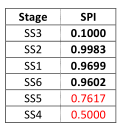For seedings, see this page: Points & Seedings
What is a Seeding List for?
Seeding lists are used to assist Event Organisers to safely prioritise drivers relative to their driving speed and to minimise the risk of competitors catching one another under normal circumstances whilst driving at competitive speeds during an event.
At the commencement of 2013, the Western Australian Rally Advisory Panel (WARAP) elected to adopt a new seeding system based on the current Australian Rally Championship (ARC) method of calculating a Drivers’ seeding.
The WA seeding method averages a Drivers’ performance over the best two of the last three events that qualified for a seeding rating. The method by which this is achieved is described in further detail below. The seeding method allows one ‘bad event’ to be dropped from the seeding calculation.
If a Driver has competed in both 2wd and 4WD vehicles, then a separate seeding for each will be given. Dual seedings are identified with a “+” sign after the Drive type, i.e. 2wd+, 4WD+.
So how does the seeding system work?
It starts by comparing your performance on a special stage where the fastest elapsed time for a stage is divided by your elapsed time on the same stage. This gives you an individual Stage Performance Index (SPI) for that stage.
Example: Part 1 – SPI Calculation

At the end of the event you will have a SPI for every stage you completed.
The top two thirds of your SPIs are averaged to produce an overall Event Performance Index (EPI). Using the top two ‐thirds means that poor/unusual elapsed times caused through flat tyres and the like, are excluded and will not adversely affect your event index.
With the exception of a State round being incorporated within an ARC event, the minimum number of stages you must complete to qualify for a seeding rating, an EPI, is two. If competing within an ARC event, then the minimum number of stages that must be completed are six for WARC contenders, and two for Clubman Cup contenders.
Example: Part 2 – Event Performance Index (EPI) Calculation
Using the SPI examples from Part 1 above, all your SPIs for an event are listed in descending order.

The top two thirds of the SPIs (top 4 if completed all stages of a 6 stage event); SS3, SS2, SS1 and SS6 are averaged to produce your EPI:
( 1.0000 + 0.9983 + 0.9699 + 0.9602 ) / 4 = 0.9821 = EPI
The best two of your last three EPIs are then averaged to give you your Drivers Performance Index (DPI), which is your seeding rating.
Example: Part 3 – DPI Calculation

In summary:
The Stage Performance Index (SPI) compares your performance for each Stage. This is averaged to determine an Event Performance Index (EPI) for each Event. The best two of your last three EPIs are averaged to determine your individual Driver Performance Index (DPI) – your seeding rating.
Seeding Lists will to be published on RallyWA.com as soon as possible after an event and will be listed in both alphabetical and DPI order.
Hope this has helped you getting a clearer understanding of how your Seeding is calculated.
Note: mail Seedings@rallywa.com if you have any questions
